In this edition of The Naked Scientists, new analysis on the prevalence of long COVID. How widespread is it? Also, could climate change be causing hurricanes in the Atlantic to get stronger? And, we ask if scientists have finally established how bees decide which flower to forage from next...
In this episode
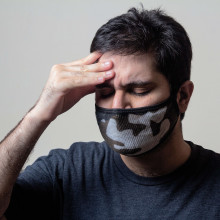
00:52 - Long COVID affects 7% of those with virus
Long COVID affects 7% of those with virus
Christina Atchison, Imperial College London
New analysis by Imperial College London has found that tens of thousands of people in England have lasting symptoms from COVID-19…more than a year after infection. The findings - which come from a representative sample of more than a quarter of a million people - suggest that 7% of those who have caught the virus have had symptoms lasting 12 weeks or more, which is classified as Long COVID. Dr Christina Atchison is from Imperial College’s School of Public Health and the first author on the study.
Christina - During the pandemic, we ran a study called the React Program, which some of your listeners may have heard of or indeed taken part in. And now we're following up with this study over a quarter of a million of those people and asking them about their current health. The main point of the study was to try and identify people that were suffering from persistent symptoms following infection with COVID and seeing how long those symptoms persisted for.
Chris - This comes under the umbrella of what is broadly dubbed long COVID.
Christina - Exactly. As far as the NHS and the WHO definition of long COVID goes, it is persistent symptoms following infection for 12 weeks or more, and that's the definition we used in the study.
Chris - Lots of people around the world have done this and we've arrived at an incidence of what we think it is in a population like the UK. So what does your study add?
Christina - A lot of previous studies have either been focused on patients who were hospitalised with COVID or focused on people just with long COVID, so haven't asked these sort of wider questions about symptoms in the general population. So we actually had two comparison groups. So people who never had COVID and also those people who got better very quickly after their infection. So after one or two weeks, which was most people. The other thing we did was we initially asked about current symptoms and health at the time in the survey, irrespective of whether people thought they had long COVID or not. And it was only later in the study that we asked them about their history of COVID and whether they thought they'd had long COVID. So we're hoping it provides much more unbiased data with respect to long COVID.
Chris - Indeed, because of course there could be social factors and everything else which was going on with a population going through a pandemic. Unsurprisingly, people are going to feel depressed, they are going to feel fatigued. They are going to feel run down in the aftermath whether or not they got COVID to some extent. And I suppose by having this big group of people, some of whom got infected, some of whom didn't, but they've all been through the same experience, you've got a really good comparison as to what really may be attributed to prior COVID infection, and what was the situation at the time.
Christina - Exactly. We found that the most common symptoms in people with long COVID were mild fatigue, difficulty thinking, concentrating - a lot of people use the term brain fog - and joint pains and shortness of breath. Now a lot of these symptoms are also fairly common in the general population, but we were able to show that they were far more common in people who had persistent symptoms following long COVID. Indeed, about 30% of people with long COVID said that their symptoms reduced substantially their ability to perform just sort of normal day-to-day activities. That percentage, 10%, was a lot less in the general population of people that either reported never having had COVID or just an acute illness. So showing really a substantial health burden in those people.
Chris - So what fraction of people got what we accept to be long COVID and what fraction of people got better and by when? So what do we think that the size of the iceberg, as it were, is now attributable to to COVID with these legacy symptoms that are going on indefinitely for some?
Christina - Overall people with COVID, with symptoms, about one in 13 developed symptoms that persisted for 12 weeks or more. So that's about 7.5%. and 1 in 20, so 5%, have persistent symptoms for more than a year. So I guess the important thing to say is most people with COVID get better and get better quickly within a couple of weeks, but about 1 in 13 do have these persistent symptoms beyond 12 weeks and 1 in 20 for more than a year.
Chris - And because you knew a lot about the people who were then going on to get these symptoms, can you flip things around and ask what the risk factors were displayed by those people that then ended up with them having those longer term or worse prognoses?
Christina - Yes, and they're very much in keeping with people that were also more at risk of catching COVID in the first place. Women were more likely to suffer from long COVID. That's quite consistent with other post viral syndromes and autoimmune conditions which are more common in women. We also found people that had severe acute infections, people that were hospitalised or were sort of really sort of bed bound with their symptoms, they again were more likely to develop persistent symptoms alongside people in clinical risk groups. So people with underlying health conditions like diabetes, respiratory problems. And importantly we found that the proportion of people with persistent symptoms fell substantially with more recent variants. So people with omicron were 88% less likely to have developed long COVID after the infection than people that were infected previously with the original Wuhan strain.
Chris - Where does this leave us then? Are we any closer to agreeing on what long COVID is and what about the implications going forward? Now we've got this understanding of who is likely to be at risk and how long for, where does this leave us?
Christina - There are still some inconsistencies in the definition. What we know is that this is real and it's a significant health burden for a not small percentage of the population. But what we just don't know yet is about the biology and what makes some people more susceptible or not.
Chris - Do you think it is unique to SARS-CoV-2, the cause of COVID, or do you think that because we had so many people succumbing to this all at the same time, that enough people raised a hand and said there's something wrong that we notice this, but were we to go and look at other infections that are seasonal or present in the same sort of way and can be as severe in some cases like the flu? Do you think we'd see a post viral syndrome attached to that too? And indeed, should we go looking?
Christina - My opinion is, this is probably seen with other infections. I mean as well as the research, I'm also a clinician and have seen people with coughs and colds and bad flus. And especially with the sort of loss of sense of taste and smell is something I've seen with other patients and have been symptoms they've had for a long time. I just think with COVID there was the whole entire world, the research community, focused on this one virus, understandably because of the impact it was having. But I would imagine if we went looking, we would also find these symptoms with other viruses. There are some similarities to something called chronic fatigue syndrome and post viral syndromes that have been reported after acute illnesses with other viruses. There is perhaps now justification to go and look at other viruses in a similar way that we've done with COVID.
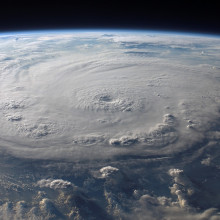
08:37 - Climate change is making hurricanes stronger
Climate change is making hurricanes stronger
Andra Garner, Rowan University
Our seas have been heating up in recent decades. In fact, the oceans have absorbed 90% of the global warming caused by climate change. Warm water is the key source of energy that powers tropical storms, including hurricanes. And Andra Garner, a climate scientist at Rowan University in Glassboro, New Jersey, has found that as the world warms, the rate at which hurricanes spawn and intensify from storms has doubled in the last 40 years…
Andra - We have seen our ocean waters warming in recent decades. Our oceans have actually taken up about 90% of the warming that's been caused by human caused climate change. And that warm water is a really key source of fuel for hurricanes that form in the ocean, including in the Atlantic. So I wanted to know if over that same time when we've seen our waters getting warmer, can we also see changes in how quickly hurricanes are strengthening?
Chris - And what did you see?
Andra - There are measurable and significant increases in how quickly storms are intensifying. So there were noticeable increases in the average fastest rate at which a hurricane in the Atlantic would strengthen. I also found changes, for example, in how often a hurricane goes from a pretty weak storm, say just a category 1 or a tropical storm into what we call a major hurricane. So category 3 or greater. And so I saw that from say the 1970s and ‘80s, up to 2001 to 2020, the chance for a hurricane to go from a weak storm into a major hurricane has more than doubled.
Chris - And so to what extent can we extrapolate this to other parts of the world because presumably the same physics is going to apply for other storms and other storm systems elsewhere and therefore it could mean that other places can expect an impact too.
Andra - Yeah, absolutely. You know, certainly I would like to take some of this work and really do the actual analysis for other regions, but as you're saying, the physics is kind of the same regardless of where you are. You know, having those warm ocean waters as well as other kinds of components for a hurricane, like fairly weak upper level winds are going to be important no matter where you are. So just earlier today we actually saw Hurricane Otis make landfall in Mexico and Hurricane Otis was in the Pacific. But it strengthened really, really quickly, going from a tropical storm to a category 5 hurricane in about 12 hours. So, I think that it's reasonable to expect that if we see some of these conditions that are really favourable for hurricanes to strengthen elsewhere as well, that we might see similar changes in the intensification rates for hurricanes there.
Chris - And the ultimate implication of what you found, what would that be?
Andra - Yeah, so I think there's a couple of take home points from this. One is that we have already seen changes in the last 50 years to the overall rates at which hurricanes are strengthening. And I think that tells us that we are already dealing with different conditions. And so our coastal communities around the Atlantic do need to be thinking about how they can prepare for the possibility that storms are strengthening more quickly, thinking about how we can maybe develop emergency action plans for our coastal communities that can adapt to this idea that a hurricane might strengthen quickly before making landfall. Just try and make those communities more resilient in that way. The other thing that I would say about these findings is that they should really serve as an urgent warning. We've seen the rates at which hurricanes strengthen greatly increase over the last 50 years. Over that same time, we've also seen changes to our ocean surface temperatures. We've seen our ocean waters getting warmer. And so I think that if we don't do something to limit additional warming, it's reasonable to expect that we might see this kind of pattern continue into the future.
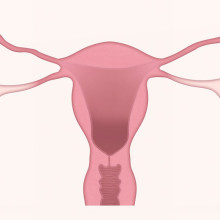
13:31 - Cervical cancer breakthrough cuts cancer recurrence by 35%
Cervical cancer breakthrough cuts cancer recurrence by 35%
Mary McCormack, UCL
But first, scientists say they have made the biggest breakthrough in the treatment of cervical cancer in 20 years. The study by researchers at University College London cut the risk of women dying from the disease or the cancer returning by around 35%. So, how did they do it? Dr Mary McCormack is the lead investigator of the trial at UCL Cancer Institute.
Mary - The gold standard is weekly chemotherapy, the drug called cisplatin, and daily radiotherapy for five weeks. That's the external component of the radiation, and then internal radiotherapy, also called brachytherapy. So it's those two components and a drug delivered once a week. That is still the gold standard and has been for 25 years.
Chris - And when you do this, hitherto, we've been achieving about a 70% success rate.
Mary - Well from trials that have been published in the last couple of years, we could expect that 7 in 10 women would be alive at five years.
Chris - And where did you think there was a gap in terms of the treatment regime, then? Where did you try and intervene differently?
Mary - The main problem we felt was that the cancer was coming back outside of the area that was treated with the radiotherapy. So we could treat the area where the cancer was, treat the draining lymph glands, but the cancer would come back, for example, in lymph glands in the belly area or it might come back in the lungs. It would come back somewhere else. That was really the problem that we wanted to tackle.
Chris - And how did you try and do it differently then?
Mary - We put a new twist on an old theme. Some years ago, people had tried to give chemotherapy before the radiation, but some of the trials weren't very well controlled, they were quite small, and there were lots of different regimens. So we said, let's take the most active drugs that we have in this type of cancer - which is carboplatin and paclitaxel - let's put those two drugs together. We know they work well, let's give them every week because that then doesn't allow the cancer cells time to recover. Let's do it for six weeks because if we do it for many, many weeks longer than that, then we may compromise the rest of the treatment. The other thing we did was we said, as soon as we've done these six weeks, we must get on with the radiotherapy immediately afterwards. We must start that in week seven because, if we leave a gap, the chances are the cancer will start to regrow again and we might potentially be worse off than we were before we did anything at all.
Chris - And how did you do the trial to compare what was the best approach?
Mary - So we recruited 500 women and randomised them. 250 women to each group, 250 to the standard treatment and 250 to the standard treatment with the additional chemotherapy for six weeks beforehand. And we worked it out in such a way that we made sure we had two groups of women that were well matched, similar ages, similar extent of the cancer, similar size cancers. We treated them, we followed them up to year five, and at each time we checked to see was there any evidence that the cancer had come back, and also how they were in general terms. Did they have any more side effects? And how were they getting on generally?
Chris - And how did the two groups compare?
Mary - So in our standard of care arm, which is our standard chemoradiation, 64% of the women were alive without evidence of cancer at five years. However, in the group where we gave the additional chemotherapy, 73% were alive without evidence of the cancer coming back. So almost 1 in 10 more women were alive at five years with the additional chemotherapy. We also then looked to see how many women were alive overall and, again, we found that in the standard arm, 72% were alive at five years. However, in the arm where we gave the additional chemotherapy, we found that 80% were alive at five years. So this is our absolute improvement of 8%.
Chris - Do you have an insight into why this is making such a difference, how it's working?
Mary - I think because we are giving weekly treatment early in the treatment of the whole disease. Also, I think we're treating those cancer cells that might have escaped and that might be lurking or nesting somewhere else, but haven't had a chance to grow. Those are the ones that we don't pick up on any scans, and if we get rid of those early, they're not going to be able to grow into secondary tumours. This is what we were able to demonstrate: that we had less recurrences in those areas like the lungs when we gave the additional chemotherapy. And I think this is probably what's accounted for the improvement in the survival rate.
Chris - It is a big reduction in mortality potentially, isn't it? Is this going to become the standard of care now, then?
Mary - I certainly hope so. Many of the centres that treat cervical cancer participated in the trial and the drugs are cheap. So this should help it to come into use widely in other parts of the world as well, particularly where this problem is even bigger; South America, Southeast Asia, places in Africa where the numbers are vast. And if they can ensure 1 in 10 extra women are alive at five years, that would make a huge difference, there.
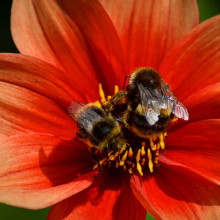
19:25 - Bees calculate energy efficiency to choose next flower
Bees calculate energy efficiency to choose next flower
Jonathan Pattrick, University of Oxford
If you've ever observed a bumblebee moving from flower to flower, you might wonder how it decides which petals to pick, and how long it should stay. Now, researchers bee-lieve they have the answer. Jonathan Pattrick, from the University of Oxford, conducted the study...
Jonathan - We used artificial flowers and gave bees a choice of visiting these flowers when they were orientated at right angles to the horizontal, or orientated horizontally. Vertical orientation, that's much more difficult for the bees to visit, it takes a lot of energy, it takes a little bit more time. We had three different tests, so we put a little drop of sugar solution in the centre of each flower. In one, the sugar concentration of both the vertical and the horizontal flowers was exactly the same. And as you might expect, the bees very quickly switched to the horizontal flowers. In the second test, we made the sugar concentration of the vertical flowers much higher, so it was much more rewarding than the horizontal flowers. In this one, the bees persisted in visiting the vertical flowers. In the third test, we made the difference in sugar concentration between the horizontal and vertical flower smaller and, in this case, the bees switched from visiting the vertical flowers to visiting the horizontal flowers.
Chris - So they are able really to estimate how much energy they're burning to get that food reward. So they know their net better off by going the extra mile when it does matter in that way.
Jonathan - Yes, but this is where it gets a little bit more complicated because there are two really common foraging currencies you might assume a bee would use. One is the rate at which they can get nectar back to the colony, the second is how efficient they're being about their foraging. And a way of thinking about that is that they're trying to maximise the amount of energy they get out from foraging for any energy they put into foraging. Those two different currencies result in different expected behaviours on our setup and also different expected behaviours from bees in the wild as well.
Chris - We're talking about currency and energy here, but we're not actually sure that that's what the bees are doing because it could just be they like the taste, couldn't it? And that they're willing to go for something a bit sweeter and pay a higher price to get something a bit sweeter.
Jonathan - So the way that our experiment was set up, coming back to these two currencies, was such that visiting these vertical flowers, it took them a little bit longer. So that has a small effect on the currency of rate of energy return to the colony, but it was much more energetically expensive. So it has a big impact on the efficiency of their foraging and so, under those two currencies, what you would predict is that when there's a really large difference between the horizontal and the vertical flowers, if bees are foraging by optimising energy efficiency, they should have switched to the horizontal flowers, where if instead they're trying to optimise the rate at which they get energy back to the colony, they should stick to foraging on the vertical flowers. And because we saw that they did in fact stick to foraging on the vertical flowers, this gives us quite good evidence that this is how they're making their foraging decisions
Chris - Given how important bees are to agriculture, especially bumblebees with buzz pollinated crops that need a big bee like a tomato. Does knowing this now help us to improve the efficiency with which certain crops get pollinated?
Jonathan - So I think knowing the currency in particular is important because it gives us the framework through which bees should be making their foraging decisions. So it just gives you a much better idea about, when faced with a choice between different flower types, which ones the bees are going to be visiting. And yes, that should be useful for guiding choices on if you've got a choice between two varieties, one with a low nectar concentration and one with a high nectar concentration, can you get away with using the one with the lower nectar concentration or does the energetic situation of how you're using bumblebees to pollinate these crops mean that actually you'll get more pollination, a high yield from your crop, by choosing the variety with the higher sugar concentration.
Chris - Or engineering a crop that has a higher nectar concentration that makes it more of a lure for bees?
Jonathan - That would be an option as well. I've previously done some work where we were looking at nectar concentrations in the field bean and we found actually there was a huge variation in nectar concentrations among different varieties of bean. So I think probably in a lot of species that variation is there already and you'd be able to just use standard breeding techniques if you wanted to grow varieties that had a favoured nectar concentration.
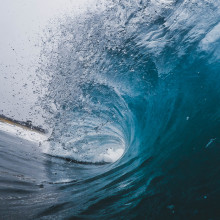
24:29 - Why is some water on Earth salty, and some fresh?
Why is some water on Earth salty, and some fresh?
Thanks to listener Joanne for the question.
As anyone who’s ever taken a dip in the sea and had the unfortunate experience of swallowing some water will know, it tastes incredibly strongly of salt.
And you’re absolutely right, this is because of minerals from rocks on land making it into the sea.
There are a few ways this happens: one of the main ones is that carbon dioxide in the air dissolves into rainwater, making it slightly acidic. When this rain falls, physical and chemical processes release minerals including sodium and chlorine from the rocks into the runoff water which either goes directly into the sea, or is eventually transported there via rivers, streams and lakes.
So rivers, although they might not taste of salt, do have these minerals in them, but they’re being carried in a continuous flow through the water system towards the sea by gravity, meaning the saltiness never accumulates.
Similarly, most lakes also have this avenue for escape for the water and minerals via the rivers and streams connected to them, so the salt doesn’t have a chance to collect there in vast quantities either.
So all roads lead to the sea, where, as Paul writes under the forum post for this week’s Question of the Week: ‘Water evaporates leaving whatever salts are present in the oceans and the evaporated water then becomes precipitation to start the cycle over again.’ And he’s exactly right. Thanks for that, Paul.
The main way water escapes is through the chemical process of evaporation. The difference with this escape route is that there’s no room for the minerals dissolved in the water to make the jump too. As water molecules with enough energy escape from the surface of the ocean into the air above, left behind sodium and chlorine raises the salt concentration of the sea.










Comments
Add a comment